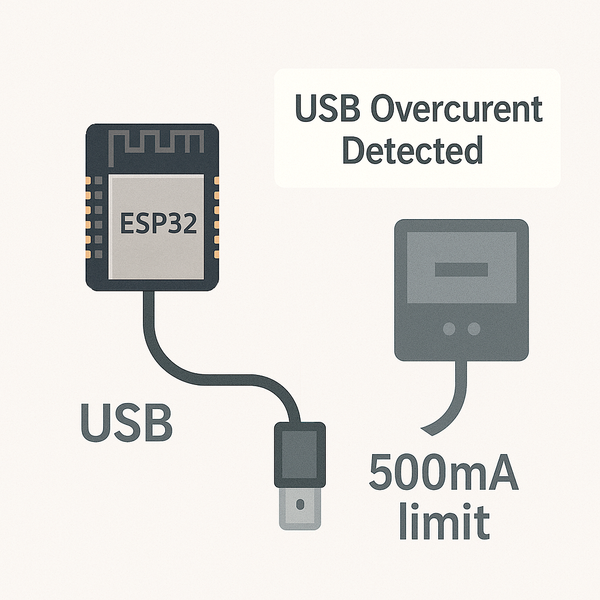ESP32 USB Current Limit
Avoid resets and brownouts caused by limited USB power. Learn how USB port limits, poor-quality cables, and hubs can affect ESP32 stability - and how to fix it with better cables, power routing, and capacitive buffering.
Common Causes
- 🔌
Underpowered USB Ports
Laptops, hubs, and docking stations often limit USB current to 100–500mA, which may be insufficient for ESP32 boards during peak loads.
- 🧵
High-Resistance or Data-Only USB Cables
Thin, long, or charging-only USB cables can introduce voltage drops or lack data lines, leading to unreliable power delivery and communication issues.
- ⚙️
USB Enumeration Limitations
Some ESP32 variants may not request higher current during USB enumeration, relying on the host to provide sufficient power without negotiation.
Symptoms
ESP32 Resets or Fails During Wi-Fi or Peripheral Activation
The board operates normally until initiating Wi-Fi or high-current peripherals, then resets or becomes unresponsive due to insufficient power.
Serial Monitor Shows Brownout or Boot Loop Messages
Error messages like rst:0xf (BROWNOUT_RST) appear, indicating voltage drops below safe operating levels.
Unstable Behavior When Connected via USB Hubs or Docking Stations
ESP32 boards exhibit inconsistent behavior or fail to operate when connected through intermediaries that limit power delivery.
Solutions
Use a High-Quality, Short USB Data Cable
Opt for USB cables that are short, thick, and known to support both power and data to minimize voltage drop and ensure reliable communication. If you are planning to flash ESP32 with the same USB cable, make sure it is data-capable.
Connect Directly to a Desktop USB Port
Bypass USB hubs and docking stations by connecting the ESP32 directly to a desktop USB port, which typically provides more stable power.
Provide External Power via VIN or 5V Pin
Supply power through the ESP32’s VIN or 5V pin using a regulated power source rated at 1A or more to meet peak current demands. See: ESP32 External Power Guide.
Add Bulk Capacitors Near Power Input
Place capacitors (e.g., 470–1000µF) close to the ESP32’s power input to buffer against transient voltage drops during high-current operations.
More Details
ESP32 USB Current Limit #
Many ESP32 issues - especially unexpected resets, failed uploads, or random crashes - are caused by insufficient USB power. While USB ports are convenient, they’re not all created equal, and the ESP32 can draw more current than some ports or cables can reliably supply.
This guide explains how to detect, diagnose, and fix problems caused by USB current limits.
Why This Happens #
The ESP32 can spike to 400–500mA during Wi-Fi startup or peripheral use. However:
- Many laptop USB ports limit current to 100–500mA, especially on battery.
- USB hubs, docking stations, or keyboard passthroughs can supply even less.
- Cheap or thin USB cables have high resistance, causing voltage drop under load.
This causes brownouts, random resets, serial upload failures, or unstable runtime behavior.
Typical Symptoms #
- Code uploads fine but the board resets during
WiFi.begin() - Serial monitor shows
rst:0xf (BROWNOUT_RST) - Device not recognized unless plugged into a different USB port
- Board works when idle, but crashes under Wi-Fi or sensor load
- Uploads fail with
"Failed to connect to ESP32: Timed out waiting for packet header"
ESP32 Current Draw Overview #
| Operation | Typical Current |
|---|---|
| Idle (Wi-Fi off) | ~40–80mA |
| Wi-Fi scan / connection | 300–500mA peak |
| Camera or OLED enabled | +100–200mA |
| Max spike (with peripherals) | 500–700mA+ |
How to Fix It #
✅ 1. Use a Better USB Cable #
Use a short, thick, known-good USB data cable. Many included "charging cables" lack proper data lines or have high resistance.
Try:
- A cable that works with Android file transfer
- USB cables from phones/tablets with fast charging
- Avoid ultra-thin or very long cables
✅ 2. Avoid USB Hubs and Docking Stations #
Connect directly to a desktop USB port. Bypass hubs, docks, or splitters, which often limit available current.
✅ 3. Power Through VIN or 5V Pin #
For power-hungry projects (e.g., ESP32-CAM, Wi-Fi + sensors), use a regulated 5V adapter supplying at least 1A. Connect:
- +5V to VIN or 5V pin
- GND to GND
Important: Do not exceed 5V - the onboard regulator handles this, but input over 5.5V can damage the board.
✅ 4. Add Bulk Capacitors #
Place a 470–1000µF electrolytic capacitor near the power input of the ESP32. This helps absorb current spikes.
+---------+
| ESP32 |
| |--- GND -------+
| | |
| |--- 3.3V ------+----||---- GND
470–1000µF electrolytic✅ 5. Lower Current Draw in Software #
If your project allows:
WiFi.mode(WIFI_OFF);
btStop(); // Disable Bluetooth
setCpuFrequencyMhz(80); // Lower CPU clock to reduce drawUse deep sleep to save energy between cycles:
esp_sleep_enable_timer_wakeup(10 * 1000000); // 10 sec
esp_deep_sleep_start();Conclusion #
Brownouts and USB upload issues aren’t always code-related - they're often electrical. Upgrading your power supply, cable, and connection method can eliminate 90% of common ESP32 startup and stability problems.

Quick Navigation
Additional Resources
Still Stuck with an ESP32 Issue? Let's solve it together.
Our interactive troubleshooting wizard will guide you through common ESP32 problems and their solutions, step by step.